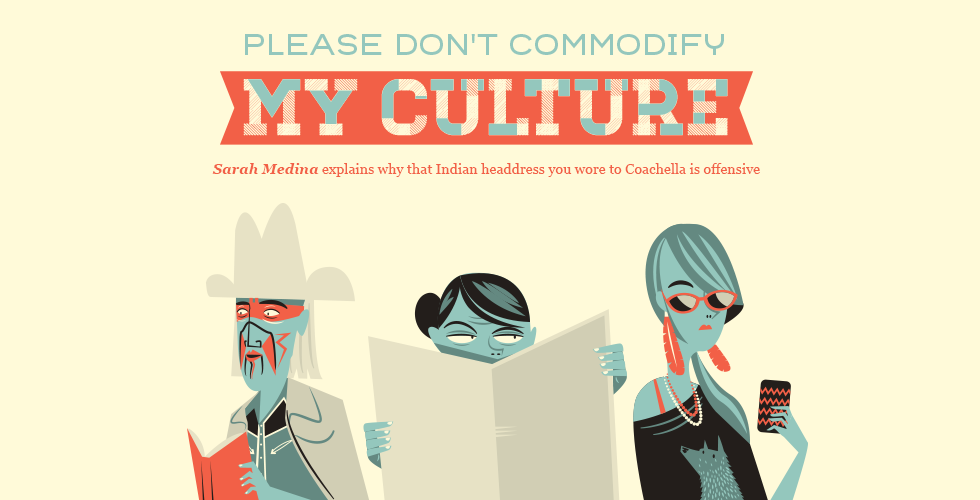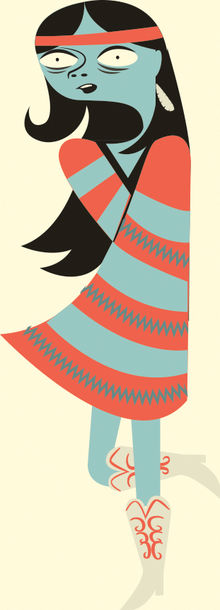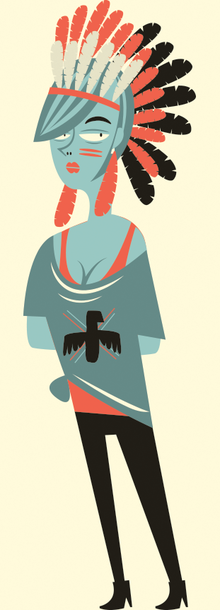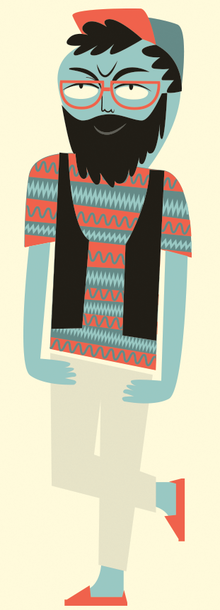By Sarah Medina


People either regale me with stories about the one time they went to a powwow because their great-great-great grandfather was 1/16th Cherokee, or people start singing “Just around the Riverbend.”
Normally, I have thick skin and can brush aside racist comments like nobody’s business. After all, I’m half Mexican and half Hopi — my mother was born in Sonora, Mexico, and my paternal grandparents were born on the Ohkay Owingeh reservation in northern New Mexico — so I’ve learned to ignore these comments all my life. There is often a big difference, however, in how today’s society treats these two races.
Saying something stereotypical about Mexicans is widely considered racist. For example, in most big cities, a person would look like an ignorant asshole if they said that all Mexicans are day laborers or that they drink a lot of tequila. And if someone had the audacity to say it anyway, there’s a good chance that a person of Mexican descent would be nearby to put him in his place. Don’t get me wrong—racism against Mexicans happens all the time, but it’s much less blatant than what I deal with every day from non-Natives. I can’t seem to stop people from comparing me to whatever vision of Indian stereotypes they have put together in their head — from history books and frequent viewings of Pocahontas — and there aren’t enough Native Americans in the world to teach the offenders a lesson.

It got worse when, in the past couple of years, American culture became obsessed with Native Americans, or rather the idea of Native Americans. White and non-white folk don colorful neon headdresses, dote over pseudo-Navajo print cloth and adorn themselves in fake turquoise as a tribute to a culture they are openly stereotyping and know almost nothing about.
You might have inadvertently been involved in these actions. Maybe you’ve gone to Coachella equipped with fringe and beaded headbands, or you’ve walked into Urban Outfitters and dished out $100 for a tribal-print backpack and an American Indian–inspired T-shirt with an eagle on it. And I bet at some point in your life, you’ve owned a pair of moccasins.
Don’t worry—you’re not the only one. And San Francisco definitely isn’t the only city to fall prey to these trends. (You can buy imitation Navajo prints at Walmart, for goodness’ sake.) And I don’t think you’re being racist on purpose. But you should know that these fairly common items are offensive to Native Americans.
These fashion statements have desensitized the meaning of traditional Native symbols and made them into consumer products. Sacred objects, which have been a part of Native American culture for hundreds of years — and often are also representative of a tragic history of oppression — are being transformed into commodities.
Here’s an example: Native Americans have used eagle feathers in ceremonies and celebrations for centuries, but in 1940 the American government, fearing that the bald eagle was becoming extinct, passed The Bald Eagle Protection Act, making it illegal to possess eagle feathers. Even though it is traditionally against Native American belief to kill an eagle — a symbol of hope and loyalty — this law was used as an easy way to arrest, fine and even imprison American Indians. Not until 1994 was the law amended so that registered tribe members could once again possess eagle feathers. That’s one complex history to think about the next time you braid feathers into your hair and head out for the day.
From a very young age, I was aware that being Native American was something different or strange to others. During a lesson on the 13 colonies and English migration in the fifth grade, my teacher asked us to write down where our forefathers had come from. I wrote that mine hailed from America. I failed the assignment, and at the top of the paper was a little note to ask my parents where they came from. From then on, I chose to keep my ethnic identity to myself — it just led to too many questions.
It wasn’t until I went to college, when the fabrics, colors and symbols that had been familiar to my family our whole lives became universally popular, that I simultaneously learned to embrace my race while understanding how it was being commodified.
During my four years at UC Berkeley, race was often at the forefront of my conversations and actions, especially among my friends who ran ethnic-oriented organizations, campaigned for more political power among minority students, majored in ethnic studies and came from very brown families. But even my predominantly brown friends feel no qualms about making ironic but racist comments about my ethnicity. They dress up as Indians for Halloween; they proudly show me their Zia tattoo; or they expect me to condone the fact that they named their dog after a tribe.


So why do the majority of people think it’s perfectly acceptable to wear ridiculous face paint and beaded headbands, get dream-catcher tattoos and appropriate Native American culture in general? In most people’s minds, Native Americans haven’t progressed past the primitive age when that dickhead Chris Columbus landed in the West Indies and sent the rest of Spain west scrambling for gold. We know that George Washington fought Indians and that Andrew Jackson sent them on the Trail of Tears — but then what? American Indians rarely appear in history books again, so that even today most Americans associate Natives with either the first Thanksgiving or casinos.
This just isn’t the case. The 20th century is riddled with Native American struggles to achieve the same basic rights as everyone else. Did you know that all Native Americans weren’t awarded citizenship until 1924? Until then they were considered wards of the state; the Bill of Rights did not apply to Natives, and they were even prohibited from leaving reservation land. Even after citizenship was granted to them, Native Americans still often had to choose between being a member of the tribe and being an American. You couldn’t be both. Not until the Voting Rights Act in 1965 and the Indian Civil Rights Act in 1968 were American Indians guaranteed basic human rights like freedom of speech and suffrage.
San Francisco should know better than to overlook contemporary Native history; after all, a major moment in the 20th-century Indian struggle happened in our own backyard. The American Indian civil rights movement — a long battle for Native rights that took place right alongside the battles of blacks and Chicanos in the 1960s — culminated in an occupation of Alcatraz Island from 1969 to 1971 right here in the Bay.
But unfortunately it’s still too easy to marginalize a people who make up less than 1% of the city and less than 2% of the United States population.
And so it’s too easy for Americans to remove themselves from the history of American Indians. Which is the reason why people — in this city and in this day and age — ask me if my father lives in a tipi (no), if he made my moccasins (no) and if I know how to use a bow and arrow (no).
Being Native American comes with a long history of oppression; but still, I can’t tell you how many people want to somehow connect themselves to an idealized version of Native society. I’ve had numerous people stop me on the street, on a hike or at a bar to ask if I am Native American. These well-meaning people go on to (annoyingly) tell me about their generous Native American sentiments. While I understand these people often have good intentions at heart, it’d be like walking up to a Vietnamese person and telling them how much you love their culture because you love pho. Associating yourself with the most commodified or popular aspects of a culture isn’t the way to show how much you appreciate it. If you really want me to believe that you sympathize with the Native plight, let’s discuss the works of Leslie Marmon Silko or how inspiring Billy Mills is.
I’m not saying that non-Natives can’t appreciate Native culture. In fact, I want more people to realize that there is a lot more beyond the pomp that people assume is our daily attire. I want more people to know that New Mexico is one of the best places on earth. That we have delicious traditional foods. That Native Americans, although they’re a small population, still exist and should have a say in modern politics. And that those Native symbols you wear have important cultural messages.
Obviously, some trends are worse than others. Please never ever wear that plastic headdress again, but go ahead and buy that turquoise ring and those moccasins — they’re pretty and comfy. But I hope when you do, you also do some research to become more aware of the sacred symbolism that comes with them.

Graphic design by Juan Leguizamon.







